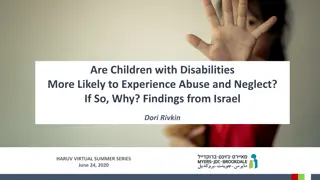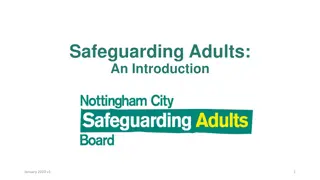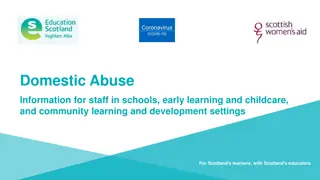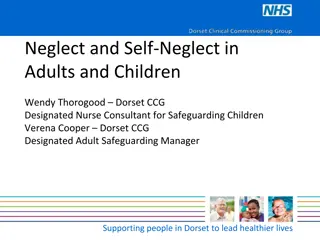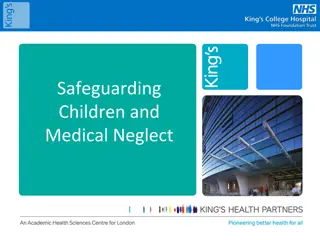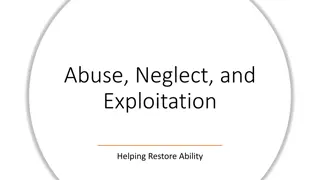Understanding Neglect and Abuse of Disabled Children
Research and practice show that disabled children are at a higher risk of abuse compared to their peers, facing various forms of mistreatment within families and other settings. Factors like learning disabilities, communication barriers, and parental relationships contribute to their vulnerability. Recognizing neglect in disabled children involves identifying signs such as failure to thrive, developmental delays, compromised immunity, abnormal behaviors around food, poor hygiene, and untreated medical conditions. Understanding these aspects is crucial for protecting and supporting disabled children effectively.
Download Presentation

Please find below an Image/Link to download the presentation.
The content on the website is provided AS IS for your information and personal use only. It may not be sold, licensed, or shared on other websites without obtaining consent from the author. Download presentation by click this link. If you encounter any issues during the download, it is possible that the publisher has removed the file from their server.
E N D
Presentation Transcript
Neglect and disabled children What do we already know
What research and our own practice tells us about abuse and disabled children That disabled children are: Over 3 times more likely to be abused than their peers More likely to experience multiple forms of abuse More likely to be abused within the family More likely to be abused at an earlier age than their peers for a longer period of time Less likely to disclose and more likely to delay disclosure Most likely to disclose to a trusted adult
Factors that add to this vulnerability Learning disabilities Communication barriers School exclusion/part time timetable Needing support with personal care Receiving care in a variety of settings A deteriorating condition A physical mobility A behavioural issue Parents relationships/engagement with professionals
So why do these things make a difference? A child with a LD may not know that what is happening to them is wrong/neglectful They may not be able to tell anyone what is going on or they may not be listened to A child who receives care from a variety of settings (parents, school transport, school, respite/specialist clubs) multiple opportunities for childs needs to be missed, ignored opportunity to shift the blame Behavioural issues can mask neglect and the behaviour becomes the focus/cause, not looking at the potential cause/reason behind it Being physically reliant on others to mobilise can require hoisting, feeding etc. risk of injury or the carer deciding when the child needs feeding/has had enough. Having a deteriorating condition ..when is it the condition progressing, when is it parental neglect? Part time timetable/exclusion lack of eyes on, impact on the parents (work, emotional wellbeing, potential resentment towards the child)
What does neglect look like? Failure to thrive how do we measure this for the disabled child? Developmental delay when is it organic, when is it neglect? Prone to illness many disabled children have compromised immunity. Sallow/sickly appearance see above! Abnormally high appetite/stealing/hoarding food there are conditions that make this behaviour more prevalent in disabled children (prada willi syndrome for example, PICA, behavioural traits associated with ASD). Smelly/dirty appearance smearing, incontinence, regurgitating food can also contribute to this. Untreated medical conditions can often be masked by behaviours/communication/abnormal pain thresholds.
Some interesting case studies for discussion A and F Both girls have a degenerative condition that means they are likely to die in childhood. They have severe dystonia and are physically difficult to handle/move and have no speech. Their understanding however is good and both girls are responsive. They are gastrostomy fed but struggle to digest their feeds and are losing weight Parents chose to not send them to school in part due to the fact that their dystonia means that the girls can only tolerate being in their wheelchairs for a short time. Dad can be challenging to work with and can be seen by some professionals as difficult . Parents first language is not English.
Parents are separated, but dad is very involved in the girls care. Mum is very protective of the girls and has said she wants to be with them all the time because she knows that they will die. Both parents have struggled to accept that the girls diagnosis and dad in particular grasps at any treatment/cure option he thinks might be viable and some that are not. There are a raft of professionals involved: social worker, dietician, consultant paediatrician, community nurses, allocated school. The case has previously been subject to CP after parents chose to use natural remedies to manage the girls dystonia and not the conventional medical route. Parents don t want to accept short break care/care within the home. It s very difficult to know what the girls think and feel about things as they re non verbal mainly based on observation and simple interaction.
So what are the concerns.. F has had 2 minor injuries to her feet . With no clear explanation The girls are losing weight Some professionals find parents obstructive The lack of stimulation that the girls receive they spend their days with mum/dad at home. Parents choice to not send the girls to school The lack of equipment in the house dad still carries the girls up and down stairs The girls prognosis and parents acceptance/understanding of this Parents preferring alternative medication to traditional.
The positives The girls respond very positively to their parents the bond is evident Mum has a good relationship with her social worker in particular, and will act on advice The girls are always well presented Both parents advocate for the girls Parents take the girls to medical appointments
Discussion. Does this appear to be neglect? Why? And what? How do we respond to/work with partner agencies when there are differing opinions on parental care of the girls? What does evidence look like in this case? What additional information would you want to feel more confident about your views? How would you begin to work with the parents?
Omission/Commission what is it? In brief . Omission means not doing something Commission means doing something Neglect is often characterised as acts of omission rather than commission but the distinction is not always clear cut. Neglect and acts of omission can include: Ignoring medical, emotional or physical care needs Failure to provide access to access to appropriate health, care, support and education services.
And another case study F is 13, severely autistic, has very challenging behaviour and is morbidly obese. He lives with his mother who also has an ASD diagnosis. In addition she has agoraphobia and MH/high anxiety. F was attending a day school but was educated in a solo classroom prior to being permanently excluded in December due to his behaviours (stripping, smearing and physical aggression) Mum finds it difficult to engage with professionals due to her anxiety and is supported via a key worker at Autism Beds who will often advocate for her at meetings.
The team have been involved with F for a number of years and to date have: Had mum and F rehoused, paid for a bespoke holiday, provided large amounts of sensory garden toys, provided respite care (when mum has agreed), referred to other agencies, worked with mum and other professionals on behaviour management strategies. F is currently having a package of emergency care at London Road. The team are sourcing a bespoke solo placement for F with the aim of addressing his behaviours, weight and to aim to re-integrate him safely with a peer group. Mum changes her mind frequently and is currently saying she won t allow F to leave her.
What are the concerns F controls his mum completely. He dictates where she can sit, when she can eat, and if she can use her phone. He will not allow her to leave the house and with 1 exception, won t allow others to visit. F refuses/cannot cope with using the bathroom and is washed either in the garden or his bedroom. Mum attempts to control his aggression with food high sugar snacks and drinks and doesn t challenge or refuse him anything. Mum and F are very isolated. No extended family apart from mums elderly father who offers emotional support when he can Mums autism makes it very difficult for her to take on new ideas/concepts/work with others. After requesting a 52 week placement, mum has now refused to accept F moving from home and is unable to take on board any professional concerns.
So what do we think..? What would you do if this was your case? Do you think F s needs are being neglected? Omission or commission? What additional info would you need to make a plan/decisions? Thinking about our assessments How would you approach undertaking an assessment of this family? How would you balance F s needs and mums? Do we consistently look to partners to inform our assessments? How do we balance their views if different to our own?
In Summary. The quality and timeliness of assessments is crucial Ensuring the disabled child has a voice however tricky that might be to gain Remembering that all behaviour is communication how would you interpret this? The balance between support and challenge how do we do this effectively? Unconscious bias . What part can this play in assessing and working with parents of disabled children?





